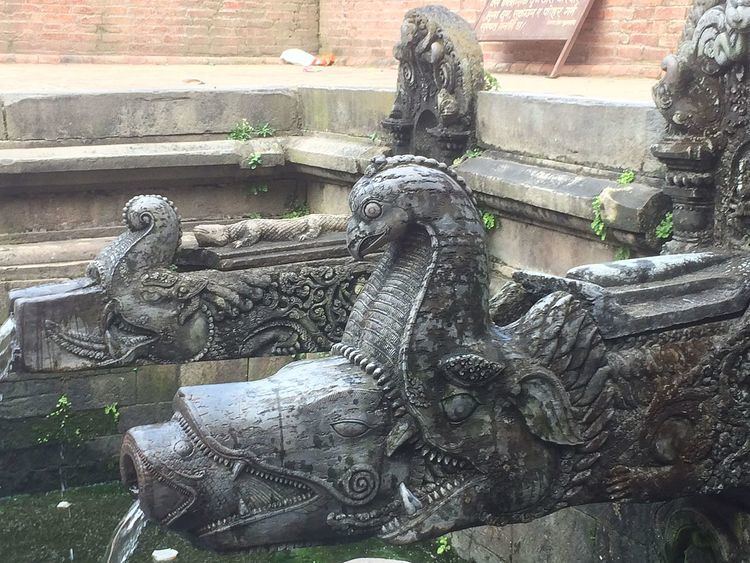 | ||
A Dhunge Dhara (Nepali:ढुङ्गे धारा Listen ) is a traditional stone water tap found extensively in Nepal. They were commissioned by various rulers of Ancient and Medieval Nepal. Dhunge Dharas were made both for public and private use, and consist of intricately carved stone water ways through which water flows uninterrupted from underground water sources. Some Dhunge Dharas were later made from metals like copper and silver as well.
The structures related to the storage, distribution and access to water- the ponds, wells, fountains, riverside ghats-are ubiquitous elements of the cultural landscape of the Kathmandu valley. Such water related structures are both utilitarian as well as architectural and engineering achievements. The meritorious function is combined with the form in ways that it creates the individually magnificent monuments and enhances the architectural design of any urban area. Not only for the mere use of water, has it had a great significance in social, cultural and historical aspects.
Water is taken as the symbol of sacredness and is considered the holiest of all. The vessel full of water, the wells, the fountains from which it issues, the pond that contains it or the stream in which it flows all are meant to be sacred. Providing access to water is thought to be very much praiseworthy which is seen till the date in the jatras and festivals. People serve the water to pilgrims and pedestrians carrying in the vessels on their shoulders to get the heavenly virtues. A significant merit is achieved whose value to society is matched by the religious merit accruing to the donor. Thus century after century of construction by the kings and common people, each according to their means, has left no corner of the valley without the water sources. These water sources comprises the elegantly carved stone structures forming dhunge dharas (lo hitis), brick lined reservoirs known as pokhari in Nepali and pukhu in Newari.
Formerly, as commendable act, drinking water was often made accessible by means of small covered tanks known as jahru in Newari (from Sanskrit jala droni). They consist of a stone trough varying in size, fixed on a masonry support or built into a wall or the side of fountain. The jahru carrying few gallons of water is replenished by means of a funnel arrangement in the rear side of the structure. The jahru is provided with one or more stoppers at the front on the reservoir. In keeping with the traditional way of the spigot at will and drink directly beneath it.
Since the lichhavis reign to more recently, the jahrus were established at the temples, tirthas, in the streets and squares. They are often built near a well or fountain to facilitate refilling them. Those jahrus are usually under a guthi endowment. The guthi serves as a care taker of the jahrus. Every first date of Baisakh the guthi performs ritual to pray the water god and renovates the jahrus. These jahrus can be found in combination with the well and nearby public shelter (pati).In addition to their utilitarian use and architectural interest, the water sources are culturally important in many other ways. Typically constructed as meritorious act, the reservoirs the hitis and the jahrus often bear dated stone inscriptions that are also important historical sources. No longer, or rarely used, most are in ruins, and their troughs abandoned or adopted to other uses as a stepping stone (upside down) at Bhairava chowk, Taumadhi-tol Bhaktapur . Among few used jahrus, the tadha jahru at tangal, patan is one and is maintained well till the date by the Joshi Guthi.
Not only the sanctity of water itself and its utilitarian use but also for the architectural, cultural and historical significance such structures need the immediate renovation and conservation. If even a small step could be moved for its conservation by reusing those magnificent structures it would be our great achievement in helping our culture, history and architecture to live longer. The request is for all the archaeologists, historians, architecture practitioners and commoners to conserve it.
